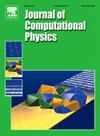A FEM towards 3D multi-component elastic interface problems and phononic crystals with nested and intersected scatterer geometries
IF 3.8
2区 物理与天体物理
Q2 COMPUTER SCIENCE, INTERDISCIPLINARY APPLICATIONS
引用次数: 0
Abstract
Developing a high efficiency and high precision numerical method for the 3D three-component elasticity interface problems with Bloch-periodic boundary conditions is challenging because of the coupled vector components of elasticity equations, the complex spatial structures and interfacial jump conditions, as well as the periodic boundary conditions. In this paper, we propose a novel Petrov-Galerkin finite element interface method to solve this problem. We choose the standard finite element basis function to be the basis of the test function, which is independent of the interface conditions and satisfies the periodic boundary conditions. Piecewise linear functions independent of the boundary conditions are constructed as the basis of the solution, which satisfy the jump conditions. The proposed method utilizes the non-body-fitted grid and projected grid to simplify the calculation. To our best knowledge, this is the first time that 3D three-component elasticity interface problems with triple junction points are solved by using non-body-fitted grids. Numerical experiments show that the proposed method can achieve near second-order accuracy in the error norm and first-order accuracy in the norm for interface problems with matrix coefficients and arbitrarily complex interfaces. With these properties, the method can be applied to the time-harmonic elastic wave equations for the band structure computation of 3D three-component phononic crystals with multiple scatterers of nested and intersected geometries. By the calculation and analysis of band structures, the influences of material properties and structural parameters are fully discussed.
三维多分量弹性界面问题和具有嵌套和交叉散射体几何形状的声子晶体的有限元分析
具有bloch -周期边界条件的三维三分量弹性界面问题,由于弹性方程的矢量分量耦合、空间结构和界面跳跃条件的复杂性以及周期边界条件的存在,对三维三分量弹性界面问题的求解具有一定的挑战性。本文提出了一种新的Petrov-Galerkin有限元界面法来解决这一问题。选取不依赖于界面条件且满足周期边界条件的标准有限元基函数作为试验函数的基。构造与边界条件无关的分段线性函数作为解的基础,满足跳跃条件。该方法采用非体拟合网格和投影网格,简化了计算过程。据我们所知,这是第一次使用非体贴合网格来解决具有三重连接点的三维三分量弹性界面问题。数值实验表明,对于具有矩阵系数和任意复杂界面的界面问题,该方法在L∞误差范数上可以达到近二阶精度,在H1范数上可以达到一阶精度。利用这些性质,该方法可用于计算嵌套几何和相交几何的多散射体三维三分量声子晶体带结构的时谐弹性波方程。通过对带结构的计算和分析,充分讨论了材料性能和结构参数对带结构的影响。
本文章由计算机程序翻译,如有差异,请以英文原文为准。
求助全文
约1分钟内获得全文
求助全文
来源期刊

Journal of Computational Physics
物理-计算机:跨学科应用
CiteScore
7.60
自引率
14.60%
发文量
763
审稿时长
5.8 months
期刊介绍:
Journal of Computational Physics thoroughly treats the computational aspects of physical problems, presenting techniques for the numerical solution of mathematical equations arising in all areas of physics. The journal seeks to emphasize methods that cross disciplinary boundaries.
The Journal of Computational Physics also publishes short notes of 4 pages or less (including figures, tables, and references but excluding title pages). Letters to the Editor commenting on articles already published in this Journal will also be considered. Neither notes nor letters should have an abstract.
 求助内容:
求助内容: 应助结果提醒方式:
应助结果提醒方式:


